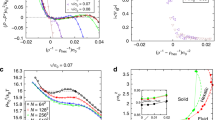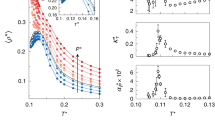Abstract
All hard, convex shapes are conjectured by Ulam to pack more densely than spheres1, which have a maximum packing fraction of φ = π/√18 ≈ 0.7405. Simple lattice packings of many shapes easily surpass this packing fraction2,3. For regular tetrahedra, this conjecture was shown to be true only very recently; an ordered arrangement was obtained via geometric construction with φ = 0.7786 (ref. 4), which was subsequently compressed numerically to φ = 0.7820 (ref. 5), while compressing with different initial conditions led to φ = 0.8230 (ref. 6). Here we show that tetrahedra pack even more densely, and in a completely unexpected way. Following a conceptually different approach, using thermodynamic computer simulations that allow the system to evolve naturally towards high-density states, we observe that a fluid of hard tetrahedra undergoes a first-order phase transition to a dodecagonal quasicrystal7,8,9,10, which can be compressed to a packing fraction of φ = 0.8324. By compressing a crystalline approximant of the quasicrystal, the highest packing fraction we obtain is φ = 0.8503. If quasicrystal formation is suppressed, the system remains disordered, jams and compresses to φ = 0.7858. Jamming and crystallization are both preceded by an entropy-driven transition from a simple fluid of independent tetrahedra to a complex fluid characterized by tetrahedra arranged in densely packed local motifs of pentagonal dipyramids that form a percolating network at the transition. The quasicrystal that we report represents the first example of a quasicrystal formed from hard or non-spherical particles. Our results demonstrate that particle shape and entropy can produce highly complex, ordered structures.
This is a preview of subscription content, access via your institution
Access options
Subscribe to this journal
Receive 51 print issues and online access
$199.00 per year
only $3.90 per issue
Buy this article
- Purchase on Springer Link
- Instant access to full article PDF
Prices may be subject to local taxes which are calculated during checkout



Similar content being viewed by others
References
Gardner, M. The Colossal Book of Mathematics: Classic Puzzles, Paradoxes, and Problems 135 (Norton, 2001)
Betke, U. & Henk, M. Densest lattice packings of 3-polytopes. Comput. Geom. 16, 157–186 (2000)
Donev, A., Stillinger, F. H., Chaikin, P. M. & Torquato, S. Unusually dense crystal packing of ellipsoids. Phys. Rev. Lett. 92, 255506 (2004)
Chen, E. R. A dense packing of regular tetrahedra. Discrete Comput. Geom. 40, 214–240 (2008)
Torquato, S. & Jiao, Y. Dense packings of the Platonic and Archimedean solids. Nature 460, 876–879 (2009)
Torquato, S. & Jiao, Y. Dense packings of polyhedra: Platonic and Archimedean solids. Phys. Rev. E 80, 041104 (2009)
Zeng, X. et al. Supramolecular dendritic liquid quasicrystals. Nature 428, 157–160 (2004)
Hayashida, K., Dotera, T., Takano, A. & Matsushita, Y. Polymeric quasicrystal: mesoscopic quasicrystalline tiling in ABC star polymers. Phys. Rev. Lett. 98, 195502 (2007)
Talapin, D. V. et al. Quasicrystalline order in self-assembled binary nanoparticle superlattices. Nature 461, 964–967 (2009)
Conrad, M., Krumeich, F. & Harbrecht, B. A dodecagonal quasicrystalline chalcogenide. Angew. Chem. Int. Ed. 37, 1384–1386 (1998)
Hales, T. C. Historical overview of the Kepler conjecture. Discrete Comput. Geom. 36, 5–20 (2006)
Hales, T. C. A proof of the Kepler conjecture. Ann. Math. 162, 1065–1185 (2005)
Glotzer, S. C. & Solomon, M. J. Anisotropy of building blocks and their assembly into complex structures. Nature Mater. 6, 567–572 (2007)
Tang, Z. Y., Zhang, Z. L., Wang, Y., Glotzer, S. C. & Kotov, N. A. Spontaneous self-assembly of CdTe nanocrystals into free-floating sheets. Science 314, 274–278 (2006)
Onsager, L. The effect of shape on the interaction of colloidal particles. Ann. NY Acad. Sci. 51, 627–659 (1949)
Kirkwood, J. E. in Phase Transformations in Solids (eds Smoluchowski, R., Mayer, J. E. & Weyl, W. A.) 67 (Wiley, 1951)
Bolhuis, P. & Frenkel, D. J. Tracing the phase boundaries of hard spherocylinders. J. Chem. Phys. 106, 666–687 (1997)
Camp, P. J. & Allen, M. P. Phase diagram of the hard biaxial ellipsoid fluid. J. Chem. Phys. 106, 6681–6688 (1997)
Veerman, J. A. C. & Frenkel, D. Phase-behavior of disk-like hard-core mesogens. Phys. Rev. A 45, 5632–5648 (1992)
John, B. S., Juhlin, C. & Escobedo, F. A. Phase behavior in colloidal hard perfect tetragonal parallelepipeds. J. Chem. Phys. 128, 044909 (2009)
Conway, J. H. & Torquato, S. Packing, tiling and covering with tetrahedra. Proc. Natl Acad. Sci. USA 103, 10612–10617 (2006)
Kolafa, J. & Nezbeda, I. The hard tetrahedron fluid: a model for the structure of water. Mol. Phys. 84, 421–434 (1994)
Frank, F. C. & Kasper, J. S. Complex alloy structures regarded as sphere packings. 1. Definitions and basic principles. Acta Crystallogr. 11, 184–190 (1958)
Fel, L. G. Tetrahedral symmetry in nematic liquid crystals. Phys. Rev. E 52, 702–717 (1995)
Yamamoto, A. Crystallography of quasiperiodic crystals. Acta Crystallogr. A 52, 509–560 (1996)
Oxborrow, M. & Henley, C. L. Random square-triangle tilings—a model for twelvefold-symmetrical quasi-crystals. Phys. Rev. B 48, 6966–6998 (1993)
Roth, J. & Denton, A. R. Solid-phase structures of the Dzugutov pair potential. Phys. Rev. E 61, 6845–6857 (2000)
Keys, A. S. & Glotzer, S. C. How do quasicrystals grow? Phys. Rev. Lett. 99, 235503 (2007)
Mikhael, J., Roth, J., Helden, L. & Bechinger, C. Archimedean-like tiling on decagonal quasicrystalline surfaces. Nature 454, 501–504 (2008)
Steurer, W. Structural phase transitions from and to the quasicrystalline state. Acta Crystallogr. A 61, 28–38 (2005)
Engel, M. & Trebin, H.-R. Self-assembly of complex crystals and quasicrystals with a double-well interaction potential. Phys. Rev. Lett. 98, 225505 (2007)
Kallus, Y., Elser, V. & Gravel, S. A dense periodic packing of tetrahedra with a small repeating unit. Preprint at 〈http://arxiv.org/abs/0910.5226〉 (2009)
Acknowledgements
The Air Force Office of Scientific Research supported A.H.-A., P.P.-M. and S.C.G. The National Science Foundation supported A.S.K., A.H.-A. and S.C.G. in the shape-matching analyses that identified local motifs. M.E. was supported by a postdoctoral fellowship of the Deutsche Forschungsgemeinschaft.
Author Contributions A.H.-A. and M.E. performed all simulations and contributed equally to the study. M.E. solved the quasicrystal and approximant structures. A.S.K. performed shape-matching analysis. X.Z., P.P.-M., and R.G.P. proposed and constructed geometric packings. All authors discussed and analysed the results, and contributed to the scientific process. S.C.G., A.H.-A., and M.E. wrote most of the paper, and all authors contributed to refinement of the manuscript. S.C.G. and P.P.-M. conceived and designed the study, and S.C.G. directed the study.
Author information
Authors and Affiliations
Corresponding author
Supplementary information
Supplementary Information
This file contains Supplementary Figures S1-S8 with Legends and Supplementary Notes and Data. (PDF 4467 kb)
Rights and permissions
About this article
Cite this article
Haji-Akbari, A., Engel, M., Keys, A. et al. Disordered, quasicrystalline and crystalline phases of densely packed tetrahedra. Nature 462, 773–777 (2009). https://doi.org/10.1038/nature08641
Received:
Accepted:
Issue Date:
DOI: https://doi.org/10.1038/nature08641
This article is cited by
-
Quasi-crystalline order in vibrating granular matter
Nature Physics (2024)
-
Colloidal quasicrystals engineered with DNA
Nature Materials (2024)
-
A columnar liquid quasicrystal with a honeycomb structure that consists of triangular, square and trapezoidal cells
Nature Chemistry (2023)
-
Chiral assemblies of pinwheel superlattices on substrates
Nature (2022)
-
Assembly of planar chiral superlattices from achiral building blocks
Nature Communications (2022)
Comments
By submitting a comment you agree to abide by our Terms and Community Guidelines. If you find something abusive or that does not comply with our terms or guidelines please flag it as inappropriate.



